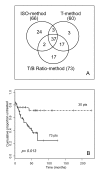Prognostic impact of ZAP-70 expression in chronic lymphocytic leukemia: mean fluorescence intensity T/B ratio versus percentage of positive cells
- PMID: 20211015
- PMCID: PMC2846891
- DOI: 10.1186/1479-5876-8-23
Prognostic impact of ZAP-70 expression in chronic lymphocytic leukemia: mean fluorescence intensity T/B ratio versus percentage of positive cells
Abstract
Background: ZAP-70 is an independent negative prognostic marker in chronic lymphocytic leukemia (CLL). Usually, its expression is investigated by flow cytometric protocols in which the percentage of ZAP-70 positive CLL cells is determined in respect to isotypic control (ISO-method) or residual ZAP-70 positive T cells (T-method). These methods, however, beside suffering of an inherent subjectivity in their application, may give discordant results in some cases. The aim of this study was to assess the prognostic significance of these methods in comparison with another in which ZAP-70 expression was evaluated as a Mean-Fluorescence-Intensity Ratio between gated T and CLL cells (T/B Ratio-method).
Methods: Cytometric files relative to ZAP-70 determination according to the three readouts were retrospectively reviewed on a cohort of 173 patients (test set), all with complete clinical and biological prognostic assessment and time-to-treatment (TTT) available. Findings were then validated in an independent cohort of 341 cases from a different institution (validation set).
Results: The optimal prognostic cut-offs for ZAP-70 expression were selected at 11% (ISO-method) or 20% of positive cells (T-method), as well as at 3.0 (T/B Ratio-method) in the test set; these cut-offs yielded 66, 60 and 73 ZAP-70+ cases, respectively. Univariate analyses resulted in a better separation of ZAP-70+ vs. ZAP-70- CLL patients utilizing the T/B Ratio, compared to T- or ISO-methods. In multivariate analyses which included the major clinical and biological prognostic markers for CLL, the prognostic impact of ZAP-70 appeared stronger when the T/B-Ratio method was applied. These findings were confirmed in the validation set, in which ZAP-70 expression, evaluated by the T- (cut-off = 20%) or T/B Ratio- (cut-off = 3.0) methods, yielded 180 or 127 ZAP-70+ cases, respectively. ZAP-70+ patients according to the T/B Ratio-method had shorter TTT, both if compared to ZAP-70- CLL, and to cases classified ZAP-70+ by the T-method only.
Conclusions: We suggest to evaluate ZAP-70 expression in routine settings using the T/B Ratio-method, given the operator and laboratory independent feature of this approach. We propose the 3.0 T/B Ratio value as optimal cut-off to discriminate ZAP-70+ (T/B Ratio less than 3.0) from ZAP-70- (T/B Ratio more/equal than 3.0) cases.
Figures




References
-
- Rosenwald A, Alizadeh AA, Widhopf G, Simon R, Davis RE, Yu X, Yang L, Pickeral OK, Rassenti LZ, Powell J, Botstein D, Byrd JC, Grever MR, Cheson BD, Chiorazzi N, Wilson WH, Kipps TJ, Brown PO, Staudt LM. Relation of gene expression phenotype to immunoglobulin mutation genotype in B cell chronic lymphocytic leukemia. J Exp Med. 2001;194:1639–1647. doi: 10.1084/jem.194.11.1639. - DOI - PMC - PubMed
-
- Crespo M, Bosch F, Villamor N, Bellosillo B, Colomer D, Rozman M, Marce S, Lopez-Guillermo A, Campo E, Montserrat E. ZAP-70 expression as a surrogate for immunoglobulin-variable-region mutations in chronic lymphocytic leukemia. N Engl J Med. 2003;348:1764–1775. doi: 10.1056/NEJMoa023143. - DOI - PubMed
-
- Rassenti LZ, Huynh L, Toy TL, Chen L, Keating MJ, Gribben JG, Neuberg DS, Flinn IW, Rai KR, Byrd JC, Kay NE, Greaves A, Weiss A, Kipps TJ. ZAP-70 compared with immunoglobulin heavy-chain gene mutation status as a predictor of disease progression in chronic lymphocytic leukemia. N Engl J Med. 2004;351:893–901. doi: 10.1056/NEJMoa040857. - DOI - PubMed
-
- Del Principe MI, Del Poeta G, Buccisano F, Maurillo L, Venditti A, Zucchetto A, Marini R, Niscola P, Consalvo MA, Mazzone C, Ottaviani L, Panetta P, Bruno A, Bomben R, Suppo G, Degan M, Gattei V, de Fabritiis P, Cantonetti M, Lo Coco F, Del Principe D, Amadori S. Clinical significance of ZAP-70 protein expression in B-cell chronic lymphocytic leukemia. Blood. 2006;108:853–861. doi: 10.1182/blood-2005-12-4986. - DOI - PubMed
Publication types
MeSH terms
Substances
LinkOut - more resources
Full Text Sources
Molecular Biology Databases
Research Materials

